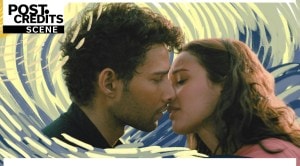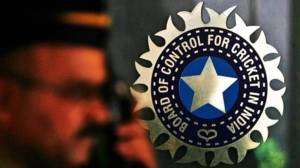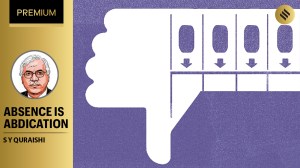Click here to follow Screen Digital on YouTube and stay updated with the latest from the world of cinema.
Heeramandi: Dear Sanjay Leela Bhansali, must your queers always be unhappy (or worse, ignored)?
In Sanjay Leela Bhansali’s hands, the character of Ustaad Ji in Heeramandi is reduced to a series of defections. His reliance on whispers as a source of power becomes reminiscent of Lord Varys in Game of Thrones — except in this world, his queerness becomes a spring board for his villainy.
 Actors Indresh Malik and Sonakshi Sinha in a still from director Sanjay Leela Bhansali’s period drama Heeramandi: The Diamond Bazaar. (Image: Indresh Malik/Facebook)
Actors Indresh Malik and Sonakshi Sinha in a still from director Sanjay Leela Bhansali’s period drama Heeramandi: The Diamond Bazaar. (Image: Indresh Malik/Facebook)People (mostly heterosexual) during my college and university years have often asked me the question, “When exactly did you know that you were gay?” As much as I have been baffled over the years by the sheer ludicrity of the question, its answer has always evaded me. Truth be told, there never really was a moment. It was a knowledge that was as granted for me, as the fact that I had been born with two hands and two pairs of eyes, and a pair of nostrils that preferred the smell of jasmine garlands over the pungent smell of marigold ones. My queerness, to the best of my knowledge, was something that was always there. Despite my best efforts to deny it, and the passage of many years before I had the vocabulary to articulate it through the verbal parameters of words like ‘homosexual’ and ‘gay’, my liking for men was something that my senses always knew as a given axiom.
Just like, growing up in a pre-Section 377 India, made me acutely aware that my libidinal desires were also a transgressive space of their own. To be shielded from the knowledge of prying cousins and disapproving aunts. Much of the queer cinematic content (mostly in the English language) I consumed secretly on YouTube back in the day, were about doomed love stories between men and women who came under violent social scrutiny because of a society’s seeming incapacity to accommodate their love. This also immediately led to a habitual association with direct emotional bonds with lonely, tragediennes on screen; whose pining and often painful pursuits of love struck a deep chord with my young heart, which knew deep down that perhaps a happy, fulfilling love was something that was never going to be my share in this life.
Even before I knew about Susan Sontag’s essay on camp, auteurs like Sanjay Leela Bhansali and their cinematic language carved a niche of absolute favouritism in my heart. Somewhere in the bejewelled, mirrored world of Chandramukhi’s many pillared mansion, and romantic resignation, I saw a loneliness that I was automatically attuned to identify with. In the blue dreamscape of Gulaab and her khwaabo-ka-sheher, watching the love story of Raj and Sakina unfold, I saw an ethereal, larger-than-life vision of inarticulated and unrequited passion — I learnt to identify my own incapacity to tell my male, best friend the crush I had harboured for him for years. And it was an association I was more than happy with, until outwardly queer characters actually began entering the Bhansali-verse.
I use the term consciously, because with auteurs like Bhansali, their films are set in a world that mere mortals can only dream of treading. It is a world bereft of any Enlightenment-era rationale. It is a world where humans interact with others of their kind — via a subset of supporting actors which include the Sun, the moon, the vast Night Sky and the thousand Stars one only dreams of ever touching. It was a fantastical world that I, like so many other queers of my generation and those before, were comfortable inhabiting. Because it offered us the space to regale in our sadness and melancholia, and showed the rest of the world around us that while their lives were destined for happy endings, the sadness we felt coiling on our chest too deserved to be projected on the screen. Until perhaps a neuron went off in my brain (perhaps largely triggered by the striking down of Section 377) and I found myself asking the question — but until when?
I remember dragging my parents to watch a late night show of Padmaavat (2018) a day after its release. The late night show was owing to my tenth grade Chemistry examination in the morning (clearly, I was annoyed at being told that the chemical consequences of two hydrogen atoms and one oxygen atom coming together was of greater consequence than a rougishly handsome monarch pining for a ridiculously gorgeous queen). My father fell asleep within the first half-hour and my mother continued fidgeting in her seat, while I leaned forward and continued looking at the theatre screen with tear-stained eyes. There was classic, melodramatic dialogue-baazi in a way they barely do in our films anymore, there were opulent frames that looked like miniature paintings brought to life and there was a lot of longing and pining (often misplaced in the context of the film, but there was a dangerously fetishistic appeal to that too).
Still, what truly and utterly stuck with me was the film’s almost suggestive bisexuality of the villainous reimagination of Alauddin Khilji (Ranveer Singh) and the androgynously visualised, absolutely queer Malik Khafur (Jim Sarbh). Khilji’s bisexuality seemed to exist solely to drive through the point concerning his animalistic sexual appetite, and while the Mediterranean tunes of Arijit Singh’s “Binte Dil” track was an absolute aural treat, the visuals of the track choreographed entirely on the homoerotic tension between Khilji and Khafur was a treat for the sore eyes — it appeared to exist in the film’s larger narrative as almost cruel ploy to exacerbate the antagonist’s clearly established villainy further. For fervent critics of the film, there were arguments posited; this was a start, perhaps in forthcoming features Bhansali would be more open to exploring better his queer characters.
 Ranveer Singh played the role of Alauddin Khilji in Padmaavat.
Ranveer Singh played the role of Alauddin Khilji in Padmaavat.
With Gangubai Kathiawadi (2022) there was Vijay Raaz’s stunning portrayal of Gangu’s rival brothel owner, the transwoman Razia. It was a performance, its artistic excellence notwithstanding, that drew even further critical backlash. Why must cis-gender male actors be recruited to play trans roles? Is it possible to forego artistic choices from their larger political implications in a world that was fast sitting up to the fallacies of queer representation in our media? Must queerness in the Bhansali-verse always be relegated to the realm of the villains? Is it enough to make a oeuvre of cinematic works, which despite lending themselves to rich queer, subtextual readings, are nothing short of unfair to their actual queer characters?
If Gangubai Kathiawadi warranted a disappointed groan from Bhansali’s loyal queer viewers, there was no warning for the cruelty of the world he conjured in his first long-format, streaming show — Netflix’s Heeramandi (2024). A lot has been written, and his being written as we speak (and rightfully so), on the series’ misrepresentation of tawaif culture. For people well-versed in the history of tawaifs in this country, the gross historical mis-equalisation of a dying performance culture with sex work is something that belies attempts at fictionalising history, and points at more concerning creative choices from an artist, who for decades has been lauded for his portrayal of thwarted female desires on screen. But if one is to take offence at the fate Bhansali reserves for his courtesans, what must one make of the arcs he attributes to his queer characters, yet again?
 Vijay Raaz played a trans character in Sanjay Leela Bhansali’s Gangubai Kathiawadi.
Vijay Raaz played a trans character in Sanjay Leela Bhansali’s Gangubai Kathiawadi.
Ustaad Ji (played by the fabulous Indresh Malik) is one of the many pimps who populate the streets of the Heeramandi bazaar. His croaking, feeble voice, his paan-stained red lips, perpetual limping hands, exquisite shawls and Machiavellian schemings from the very onset, prepare the viewers to see him as the queer persona that he is. In a striking scene with Fareedan (Sonakshi Sinha), we see her offering a bejewelled nose ornament for his services. As Ustaad Ji is made to wear the same, he stares into his mirrored reflection with deep longing in his eyes — a silent gaze that conveys years of subdued and suppressed queer desires in his heart. We realise the space of the Heeramandi immediately as a conduit, whose fringe existence in the Bhansali’s fictional reimagination of Lahore, allows breathing space to non-normative personas like Ustaad Ji. It is a moving scene, and one that makes us anticipate more to come — except they never do.
In Bhansali’s hands, Ustaad Ji’s character is reduced to a series of defections. His reliance on whispers as a source of power becomes reminiscent of Lord Varys in Game of Thrones — except in this world, his queerness becomes a spring board for his villainy. Instead of a backstory, what we get is a deeply disturbing scene where another villainous bisexual English general consummates a consensually-murky sexual act with Ustaad Ji, only to buy his loyalty in a bid to defeat Mallikajaan. It is something the narrative is unbothered by, and in return expects us to be unbothered by. Even more bizarre is a scene in the second episode of the series, where Fareedan is seen taking a woman to bed — a provocative suggestion of a lead character’s queerness that is never returned to, or put to question again.
In her book “Promise of Happiness”, Sara Ahmed essays an exquisite chapter called “Unhappy Queers” where she discusses Vin Picker’s conversation with her publisher in 1952, where the latter agrees to publishing the author’s lesbian pulp on the singular condition that her characters meet with an unhappy end. As Ahmed piquantly notes, the navigation of queer unhappiness in any study of queer archives, is a tricky business. The centrality of an almost imposed sense of sadness to a queer genealogy, while being undeniable is also something that is in equal parts troubling. However, the aspirational happiness of the queer, in a world that is unhappy with its queerness, is never not possible. The radical nature of this aspirational movement, Ahmed argues, is to allow the queer enough breathing space. To exist, freely and complexly, in its own inherent queerness.
Finishing the tiring eight episode long Heeramandi, I did not know what I felt sadder about — the gross historical inaccuracy of his work or the violent domestication of his female lead or the narrative’s complete ignorance of queer lives. While the inclusion of queer lives in a pre-Independence narrative is admirable, must the queer in the Bhansali-verse solely exist to further a project of villainy? Or be an unbearable vehicle of sadness? Of which, there is more than enough in the imperfect world that surrounds us today. Dear Mr. Bhansali, for all your wielding of queer aesthetics, can you just for once let your queers breathe and not forget them half-way?


Photos
- 01
- 02
- 03
- 04
- 05































